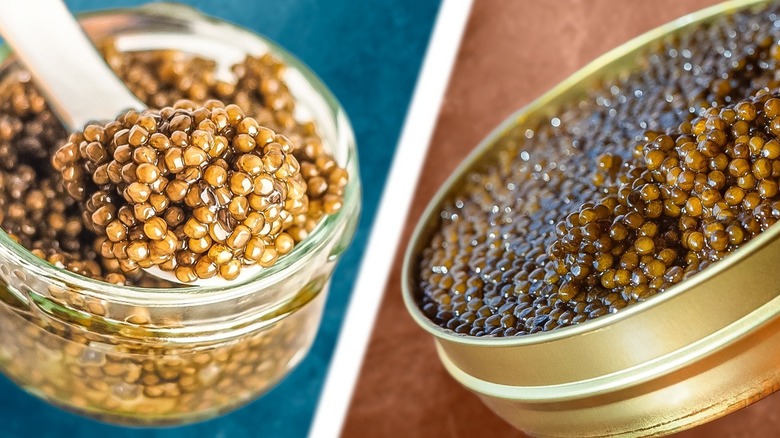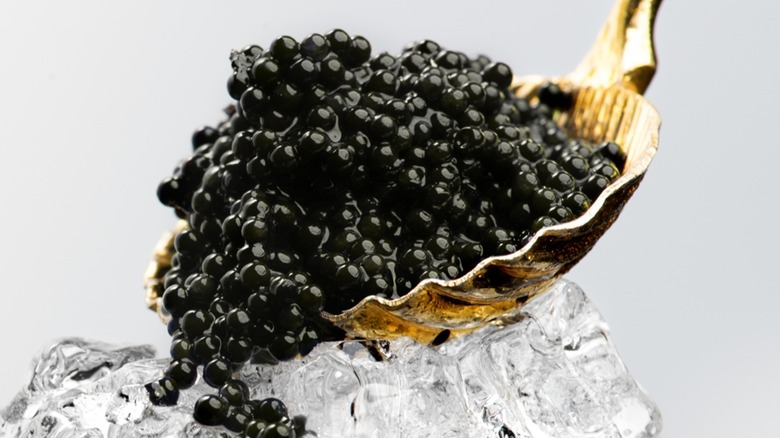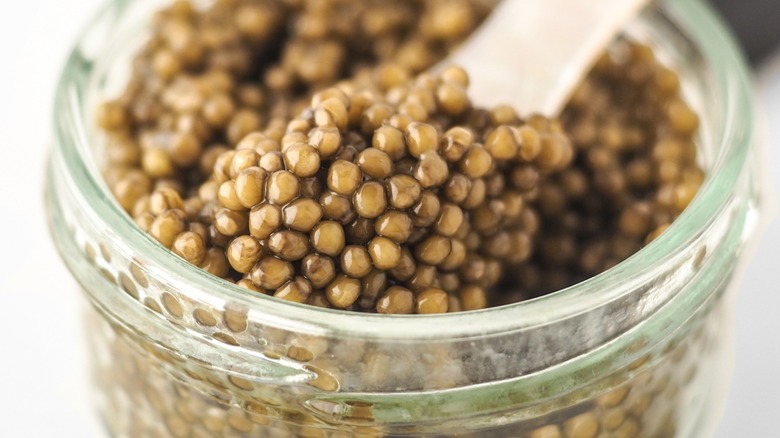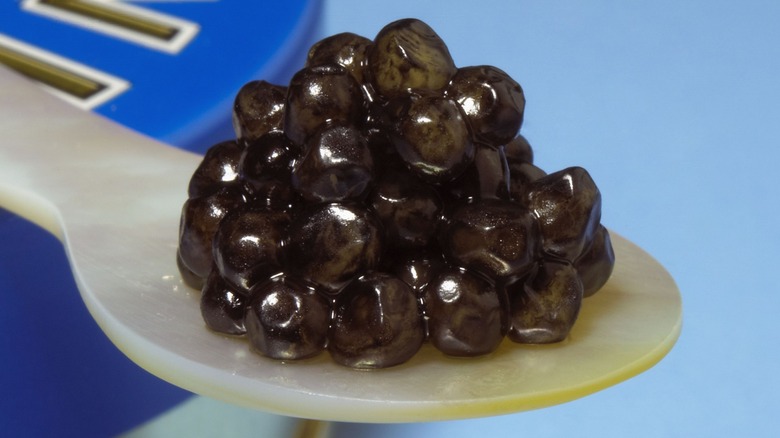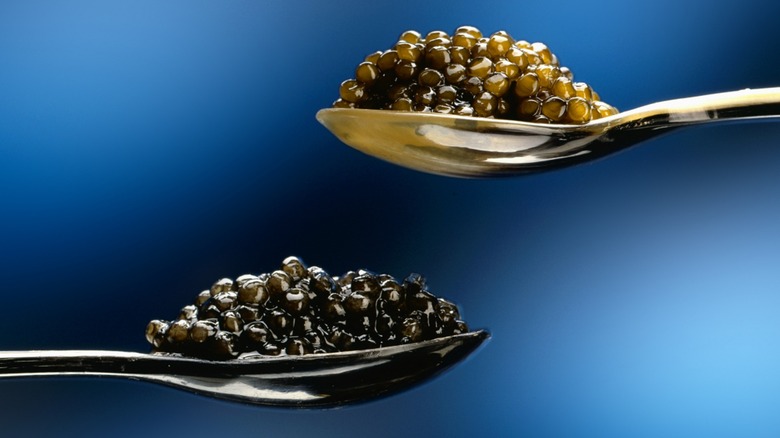Beluga Caviar Vs Osetra: What's The Difference?
From the tiny orange masago found on sushi to dried Italian bottarga, fish roe comes in many forms. However, few hold the luxurious status of caviar — one of the most expensive foodstuffs around. While the high-priced, salt-cured bites are often grouped into a single category, there are actually many different types.
All caviar is derived from sturgeon, with all other fish eggs being referred to as roe — though caviar is technically just a specific type of processed roe. Around 29 species of sturgeon exist globally, with most inhabiting the Caspian Sea region of Asia and the temperate waters of North America. In addition to the species of fish it's derived from, sturgeon roe is further delineated into varying grades of quality and appearance.
The two most famous types of caviar are the shiny, black beluga caviar and the smaller, paler osetra caviar, with the former, especially, being considered one of the most exclusive foods around. Yet, there's more that differentiates the two types than availability. Each type of sturgeon roe has its own flavor, appearance, and characteristics. Let's dive into the details of what sets these two caviars apart.
What is beluga caviar?
Highly regarded beluga caviar is harvested from a sturgeon of the same name, the beluga sturgeon (Huso huso). With a history dating back over 200 hundred million years to the Jurassic period, these fish live long lives, with some 15 years necessary for females to form the esteemed roe. As a result, overfishing has led to the species' near extinction, with only a small portion still inhabiting its native Caspian and Black Sea regions. The U.S. banned the importation of wild-caught beluga caviar in 2005, further amplifying its exclusivity.
Nevertheless, farm-raised beluga caviar is available, meaning people can still obtain the delectable roe. Beluga caviar is prized for its complex, savory, and slightly salty flavor. The consistency is smooth and each egg is large in size, producing a satisfying pop when eaten. The color is dark, typically presenting in shades of deep brown to pitch black, and the eggs have an attractive sheen. When picturing a serving of black caviar, beluga is likely the imagined variety.
What is osetra caviar?
Osetra caviar, also spelled ossetra, comes from the analogously named osetra sturgeon fish (Acipenser gueldenstaedtii). Like the beluga sturgeon, these creatures are large, reaching well over 6 feet in length and weighing around 400 pounds. Native to the Caspian Sea, they're more adaptable to different environments than other species, allowing the fish to be raised in other regions, including the U.S. Due to its endangered status in the wild, the roe of osetra sturgeons is also primarily obtained through farming.
The produced roe — which takes up to a decade to mature — has a wide range of colors, which often include a yellow tint. The eggs are smaller in size and often have a firmer texture but still produce a palatable pop when chewed. Their flavor is savory, with notes of nuts and butter, an oily smoothness, and a touch of salt. Such delicious qualities, matched with an attractive appearance, make osetra a beloved caviar type. Since it's much more readily available and is slightly more affordable, it provides an ideal foray into the world of caviar.
Beluga and osetra caviar exhibit visual differences
When examining batches of caviar side by side, it's often possible to differentiate them visually. Beluga has a much darker hue. It's typically deep brown and black, reminiscent of black olives. It also has a bright sheen with a sparkling, pearl-like quality. The individual eggs are also larger than osetra eggs, being up to 20% bigger in diameter. Meanwhile, osetra caviar takes on a much larger range of colors and sizes.
Since this sturgeon more readily adapts to new conditions, many different environmental factors impact the roe. The colors vary from pale yellow to dark black with shades of golden brown in between. Some bites of roe exhibit a sparkling golden hue, while others are paler in their tint. Overall, osetra is often lighter in tone than beluga. However, the two caviar types do have some overlap, so the difference isn't always distinguishable. You should always purchase caviar from a reputable dealer to be certain.
Beluga's rarity and flavor garners a higher price tag
Both beluga and osetra caviar offer delectable and unique culinary experiences and are distinct from other fish egg types. However, the difficulty of obtaining beluga caviar, combined with its more complex flavor, grants it a significantly higher price tag. Beluga caviar is one of the world's most expensive foods, and prices often reach several thousand dollars per pound. This is because many nations have banned the sale of eggs harvested from wild-caught fish, only a handful of purveyors are available in certain countries, and farming a single batch of eggs often takes over a decade.
However, that's not to say that osetra caviar is a drastically more affordable alternative. It often sells for half the price of beluga caviar, but it's still an expensive luxury food product. Beluga's elevated reputation is accompanied by its culinary qualities, as this type of caviar often has a more complex flavor profile with a tinge of sweetness and other unique notes as well as more balanced saltiness. Nevertheless, osetra still offers a delicious palate, and the exact flavor depends on the variety. So, feel free to seek out either caviar type; neither is likely to disappoint.
